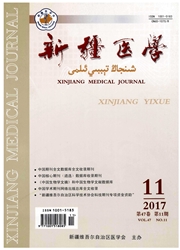

 中文摘要:
中文摘要:
目的观察肥胖型高血压患者脉压水平和代谢指标的特点以及原发性高血压(EH)患者体重指数(BMI)与上述指标的关系。方法所有入选的EH患者(646例)均进行动态血压监测及血脂、血糖、血清肌酐(Scr)、尿酸(UA)等生化指标的检测,按BMI标准划分为:肥胖组(244例)、超重组(281例)及正常组(121例),分析三组之间脉压水平及上述代谢指标的差异。结果与正常组相比,肥胖型高血压患者具更高的脉压及血清总胆固醇(TC)、甘油三酯(TG)、空腹血糖(FBG)、Scr及UA水平,更低的高密度脂蛋白胆固醇(HDL-C)水平(P〈0.05)。控制年龄因素后进行偏相关分析显示,EH患者的BMI水平依次与UA(r=0.285)、脉压(r=0.253)、收缩压(r=0.248)、TG(r=0.184)、舒张压(r=0.137)、FGB(r=0.114)、TC((r=0.106)及Scr(r=0.100)呈正相关,与HDL-C呈负相关(r=-0.136)。多元线性回归分析显示,EH患者的BMI与脉压(β=0.085)、TG(β=0.255)及UA(β=0.009)水平呈独立正相关(P〈0.05)。结论肥胖型高血压患者的代谢异常较正常及超重体型的高血压患者更为严重,EH患者的BMI水平与脉压、TG及UA水平的关系最为密切。
 英文摘要:
英文摘要:
Objective To investigate characteristics of pulse pressure and metabolic indicators in hypertensive patients with obesity and find out the relationship between them. Methods All enrolled essential hypertensive patients (n=646) were performed ambulatory blood pressure monitoring and biochemical tests. The subjects were divided into three groups on the basis of BMI, which were obesity (n=244), overweight (n=281) and normal group (n=121), respectively. The level of pulse pressure and biochemical characteristics between the three groups were analyzed. Results Compared to normal group, hypertensive patients with obesity suffered higher levels of pulse pressure, serum total cholesterol (TC), triglyceride (TG), fasting blood glucose (FBG), creatinine (Scr), uric acid (UA) and lower high density lipoprotein cholesterol (HDL-C) (P<0.05). Correlation analysis controlled by age showed that BMI was positively correlated with UA(r=0. 285), pulse pressure(r=0.253), SBP(r=0.248), TG(r=0.184), DBP(r=0.137), FGB(r=0.114), TC((r=0.106), Scr(r=0.100)and negative correlated with HDL-C (r=-0.136). According to multiple linear analysis, BMI was independent positively correlated with pulse pressure (β=0.085),level of TG (β=0.255)and UA (β=0.009)(P〈0.05). Conclusion The metabolic disorders in hypertensive patients with obesity were more serious than patients with normal BMI or overweight, and pulse pressure, level of TG and UA were most close to BMI in patients with EH.
 同期刊论文项目
同期刊论文项目
 同项目期刊论文
同项目期刊论文
 期刊信息
期刊信息
